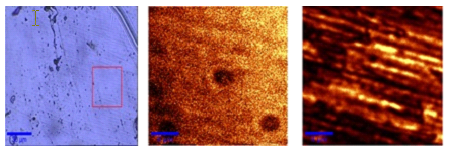Moscow State Technical University of Radio Engineering, Electronics and Automation, 119454, Vernadskogoprosp., 78, Moscow, Russia
«Poster report»
OF THE REPORT:
K.A. Brekhov, K.A. Grishunin
K.A. Brekhov
Investigating the effect of induced optical inhomogeneities in the crystal ferroelectric semiconductor Sn2P2S6 by confocal microscopy
One of the main problems of modern micro-and nanoelectronics is to increase the information speed of writing and reading processes. For this purpose, the search of new functional materials is constantly going. Various magnetic materials and structures are traditional objects of research in this area. It has been shown[1], that the fastest way from the existing to switch magnetic moment is the impact of ultrafast electromagnetic pulses, for example, femtosecond laser pulses.
In contrast to the magnetic state, optical control of ferroelectricity can be much easier, because ferroelectric order parameter (polarization) is directly related to the degree of freedom of the lattice.
The material Sn2P2S6 was chosen to investigate this possibility, because it is a ferroelectric- semiconductor by nature, and the possibility of its use as electronic components is higher than that of ordinary ferroelectrics. The optical properties of the crystal studied in detail since 2004. A lot of data has already received [2-5], but at this point, this material has not yet been investigated.
We show here the results of the experimental study by optical linear and nonlinear microscopy of the surface morphology and domain structure of Sn2P2S6 crystal arising under femtosecond laser illumination. On figure 1 photo, linear and non-linear images of the sample are shown. The linear mapping of the sample and mapping of the optical second harmonic by scanning confocal microscopy at different pump powers of the incident radiation was made. Also microscopic images at different directions of polarization of the incident radiation obtained. Furthermore, mapping at different polarization directions at twice the frequency of the pump was obtained too. The conclusions of the domain structure of the crystal were made

Fig.1 Confocal, linear and non-linear image of the sample, 20х20 microns
This results are the basis for further studies of ultrafast control of the ferroelectric polarization by femtosecond laser pulses, as well as for studies of acoustic wave arising from such pulses with ultrafast time resolution.
1. C. D. Stanciu et al, All-optical magnetic switching, Phys. Rev. Lett. 99, 047601 (2007).
2. D. Haertle, A. Guarino, J. Hajfler, G. Montemezzani and P. G¨unter, “Refractive indices of Sn2P2S6 at visible and infrared wavelengths”, Optics Express 13, 2047–57 (2005).
3. T. Bach, M. Jazbinsek, G. Montemezzani, P. Günter, A.A. Grabar and Y.M. Vysochanskii,“Tailoring of Infrared Photorefractive Properties of Sn2P2S6 Crystals by Te and Sb Doping”, J. Opt. Soc. Am B, Vol. 24, No. 7 (2007).
4. R. Mosimann, P. Marty, T. Bach, F. Juvalta, M. Jazbinsek, P. Günter and A.A. Grabar,“High-Speed Photorefraction at Telecommunication Wavelength 1.55 mm in Sn2P2S6:Te”, Optics Letters, Vol 32, No. 22, 3230-3232 (2007).
5. F. Juvalta, R. Mosimann, M. Jazbinsek and P. Günter,“Fast Dynamic Waveguides and Waveguide Arrays in Photorefractive Sn2P2S6 Induced by Visible Light”, Optics Express, 17, 379-380 (2009).